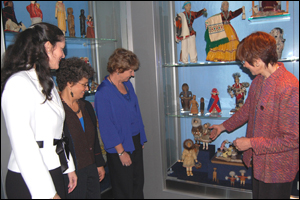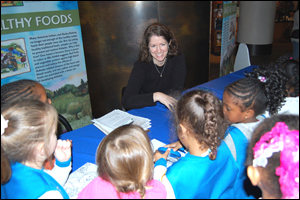Diabetes Work on Display at Smithsonian
Published: December 12, 2008

Kathleen Toomey, MD, MPH, director, CCHP shows Ann Albright, PhD, RD, director, DDT, Rosie Henson, deputy director, NCCDPHP, and Janet Collins, PhD, director, NCCDPHP a doll that was created by the great grandmother of a friend of hers from Alaska.
The original artwork from the Eagle Books series is on display at the Smithsonian's National Museum of the American Indian (NMAI). Through the Eyes of the Eagle: Illustrating Healthy Living for Children is the first exhibition at NMAI targeting children. This first-time partnership between CDC and the Smithsonian was the result of a collaborative effort between the Division of Diabetes Translation, the National Center for Chronic Disease Prevention and Health Promotion, and the Global Health Odyssey Museum.
"Through the Eyes of the Eagle is Global Health Odyssey's first traveling exhibit," said Louise Shaw, curator, GHO Museum. "So to launch its tour at the Smithsonian is quite an auspicious start, providing us a national stage. Furthermore, we have so much enjoyed the collaboration with the Native Diabetes Wellness Program."
Shared Stories
The exhibition began with a CDC Foundation-sponsored evening reception in October. Kathleen Toomey, MD, MPH, director, Coordinating Center for Health Promotion, spoke about CDC's broad range of diabetes prevention and control efforts led by the Division of Diabetes Translation, and shared stories about her own experiences working in Indian Country.
"We talk a lot about getting our public health messages out to different audiences in different venues; the Eagle Book exhibit is such an incredible example of how we can raise awareness about the importance of physical activity and nutrition to the millions of visitors who come through the Smithsonian Museums each year," she said. "It's such an honor and a real testament to the work of our staff that this project is the first CDC exhibit ever to be showcased at the National Museum of the American Indian."
Charles Stokes, president and CEO, CDC Foundation, was the emcee for the opening reception, and underscored the importance of health promotion to communities disproportionately impacted by the burden of diabetes and the Foundation's work to help CDC do more, faster.
Plate Full of Color
The exhibition is on display through January 4 at the NMAI in Washington, D.C., and New York City. Original watercolors featured in the books Through the Eyes of the Eagle and Plate Full of Color will be on display in Washington, D.C. Artwork from the other two books, Knees Lifted High and Tricky Treats, will be exhibited in New York.

Rachel Ciccarone, MPH, health communications specialist, NCCDPHP, talking to 5-year-olds from Daisy Troop #742, Fort Meade, about the importance of healthy eating and physical activity to prevent type 2 diabetes
Both venues sponsored programming that included school group tours, cooking demonstrations, teacher's workshops, storytelling, Eagle Books animated DVD screenings, and book readings. Motivational speaker and Olympic hopeful, 14-year-old Caitlin Baker who has been distributing the books to American Indian children for two years, spoke to school groups and teachers about the importance of healthy eating and physical activity.
The Division of Diabetes Translation's Native Diabetes Wellness Program has also launched the Eagle Books Community Outreach Campaign. From 2008 through 2012, American Indian and Alaska Native communities throughout Indian Country will have an opportunity to host a 4-5 day series of events celebrating the Eagle Books and their culturally-relevant messages about physical activity and healthy eating.
Highlights include large panels of images of the Eagle Books' pages accompanied by health messages, storytelling, diabetes talking circles, healing art workshops, a powwow, school events, viewings of the animated Eagle Books on DVD, and seasonal events that coincide with local activities.
Eagle Book in Schools
The first community outreach campaign was co-sponsored with Keweenaw Bay Ojibwa Community College. The Eagle Books Outreach Campaign in the Keweenaw Bay Indian Community was held in Michigan's Upper Peninsula. Keweenaw Bay Indian Community was selected as the pilot site for the Eagle Books Community Outreach Campaign because of the community's widespread use of the Eagle Books in its local schools and the role of Keweenaw Bay Ojibwa Community College in integrating the Eagle Books into the Health is Life in Balance Diabetes Education in Tribal Schools Curriculum.
The Eagle Books are a series of four books for Native American children and those interested in healthy living. The books promote diabetes prevention and encourage a return to traditional ways, including physical activity and healthy eating. The series was developed by the Division of Diabetes Translation's Native Diabetes Wellness Program in collaboration with the Tribal Leaders Diabetes Committee and the Indian Health Service's Division of Diabetes Treatment and Prevention in response to the disproportionate burden of diabetes among American Indians and Alaska Natives and the lack of diabetes education materials for children. More than 2 million books have been distributed throughout Indian Country, the rest of the United States, and abroad.
More information about the books and ordering information is available at Publications and Products.
Related Links
Get email updates
To receive email updates about this page, enter your email address:

